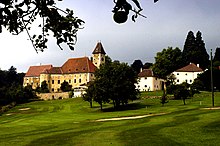Goldegg Castle (Lower Austria)
The Goldegg Castle stands high on a southern spur of Dunkelsteinerwald 1 in Goldegg on no. In the municipality Neidling Lower Austria.
Goldegg Castle
A Wézil von Goldegg is mentioned in a document in 1293. The sovereign property went to the Goldegg family as a fief in 1326, which is the basis for the name of the castle and the place. This was followed by further changes of fiefdom and ownership. In 1495 the chapel was named under the owner Stephan Uttendorfer. From 1589 to 1639 the existing castle with donjon, palas and chapel was transformed into a large, irregular, three-winged palace from the late renaissance through a generous redesign by the Enenkel family . In 1641 the castle came to Johann Mathias Prücklmayer , Baron von und zu Goldegg, who bequeathed it to his daughter. The latter sold it in 1669 to the Trautson family , who began to further expand the facility. From 1782 to 2015 the castle was owned by the Auersperg family . In 2014 the property passed to Egmont Auersperg's daughter and thus to the Auersperg-Zaksek family. War damage from 1945 was later repaired.
In the south-west of the palace complex, the almost square keep and hall of the castle can be seen. This is followed in the east by the later chapel, which protrudes or was built in front with the choir far south. The mansion with the adjoining gate tower was then built further to the east. A kitchen wing was added to the north in the axis of the chapel. The extension of the mansion and kitchen wing was then provided with a castle courtyard, which was provided with a corner tower in the northeast corner.
Castle chapel
The three-bay chapel of the Crucified Savior is vaulted with a groin and rich stucco from the end of the 17th century. The altarpiece Christ on the Cross is by Josef Baldauf from 1839. The canvas paintings of St. Andrew, who surrounds the cross from 1745 and Christ in Limbo from 1747 are by Martin Johann Schmidt . In the atrium next to the chapel entrance is a grave slab for Charlotte Auersperg, née von Lasberg, from 1743.
Castle garden
To the north of the castle is a castle garden as the main example of Lower Austrian garden art. The Goldegger Bach and other watercourses required several bridges. There is a small pond with an island. Notable buildings are a wooden pleasure house with an elliptical floor plan and shingle roof around 1800 and a two-storey glass house with a supporting structure made of iron around 1900.
Small monuments
There is a statue of St. Johannes Nepomuk on a volute base from the middle of the 18th century. There is a Marian column from 1910 in the palace garden.
literature
- Dehio Lower Austria south of the Danube 2003 , Goldegg, Goldegg Castle, pages 537 to 540
Web links
- Entry via Goldegg Castle (Lower Austria) to Burgen-Austria
Coordinates: 48 ° 14 ′ 13.6 ″ N , 15 ° 31 ′ 52.5 ″ E
